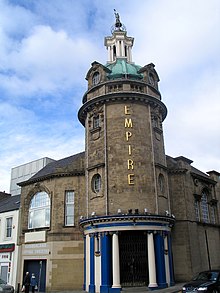Sunderland Empire Theatre
| Empire Palace | |

Shown here are the Main Doors, with the secondary Stalls entrance to the left. The Box Office is located 20 yards down the street.
|
|
| Address | High Street West Sunderland United Kingdom |
|---|---|
| Coordinates | 54°54′23″N 1°23′21″W / 54.90638°N 1.3892°W |
| Owner | Leased by Ambassador Theatre Group (City of Sunderland Council) |
| Capacity | 2200 |
| Opened | 1 July 1907 |
| Website | |
| Sunderland Empire Theatre website at Ambassador Theatre Group | |
The Sunderland Empire Theatre is a large theatre venue located in High Street West in Sunderland, North East England. The theatre, which opened in 1907, is owned by City of Sunderland Council and operated by Ambassador Theatre Group Ltd, on behalf of Sunderland Empire Theatre Trust.
The Sunderland Empire is one of the largest venues in the North East, with 1,860 seats and the capacity to accommodate 2,200 when all standing positions are occupied. The auditorium is also one of the few remaining in the UK to have four tiers, namely the Orchestra Stalls, the Dress Circle, the Upper Circle and the Gallery. There are four private boxes on the Dress Circle level, as well as two proscenium boxes on the Upper Circle balcony.
The Empire Palace, as it was originally called, was established independently by Richard Thornton after his partnership with theatre magnate Edward Moss was dissolved. It was opened on 1 July 1907 by variety and vaudeville star Vesta Tilley, who had laid the foundation stone on 29 September 1906.
The dome on the 90 ft tower featured a revolving sphere bearing the statue of Terpsichore, the Greek Muse of dance and choral song. These were removed during World War II for safety reasons, after a bomb which had fallen nearby rocked the building. The original statue is now located at the top of the main staircase, with a replica on the dome itself. The dome and tower have recently been refitted with a state-of-the-art LED and floodlight system that illuminates the main entrance in the evening.
Until the mid-twenties, the Empire enjoyed much extended success from its variety performances. With the decline of touring theatre, a projection box was added in 1930 and for the first time, the theatre played host to motion pictures. On 5 November 1956 Tommy Steele made his stage debut heading the bill in a variety show. Steele, Britain's first rock 'n' roll singer, went on to become one of the world's leading song and dance men appearing at the Empire many times. Although audience figures were high during the 1940s and early 1950s, the theatre closed in May 1959 due to the growing popularity of television and cinema. It reopened in 1960, however, after Sunderland Council bought the theatre. The Beatles performed there during their first UK national tour.
...
Wikipedia
